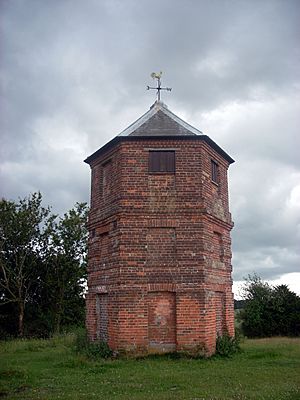The Pepperbox facts for kids
The Pepperbox, also known as Eyre's Folly, is a unique tower located on Pepperbox Hill. This hill is the highest point of a chalk ridge about 8 kilometers (5 miles) southeast of Salisbury, a city in Wiltshire, England. Built in 1606 by Giles Eyre, the tower is a three-story building with six sides, made of brick. Its doors and windows are now blocked up. The original reason for building The Pepperbox is not fully known. Some people think Giles Eyre built it to see Longford Castle. Others believe it was a special lookout spot for local landowners' wives, like Eyre's wife Jane, to watch hunting events. The Pepperbox is thought to be one of the oldest "follies" in England. A folly is a building made for decoration or fun, not for a practical purpose like living in. This tower is also a Grade II listed building, meaning it is an important historical structure. The National Trust now owns both the tower and the hill it stands on.
Contents
What is The Pepperbox?
The Pepperbox is a tower with six sides, shaped like a hexagon. It has three stories and is built from brick. The roof is low and shaped like a pyramid, made of Welsh slate. A weather vane sits on top of the roof. Around the year 1900, the roof was rebuilt.
Why is it called "The Pepperbox"?
The tower got its name because it looks a lot like an old-fashioned pepper pot or pepper box. These were used in the 17th and 18th centuries. Because of the tower's shape, the hill it stands on also became known as Pepperbox Hill.
Where is The Pepperbox located?
This interesting tower stands at the very top of Pepperbox Hill. This hill is a chalk ridge located southeast of the city of Salisbury in Wiltshire. The tower is officially in the area of Whiteparish. However, it is more closely connected to the village of Alderbury, which it overlooks. From the hill, you can see far and wide, including great views over Salisbury.
The Tower's History and Purpose
Historians believe Giles Eyre of Brickworth House built The Pepperbox in 1606. This is why it is also called "Eyre's Folly." Giles Eyre was the father of a settler named John Eyre and the grandfather of a judge also named Giles Eyre.
Why was The Pepperbox built?
The exact reason for building the tower is a mystery. One idea is that Giles Eyre was impressed by the grand Longford Castle, which was built by Sir Thomas Gorges. Eyre might have built The Pepperbox so he could look out over the castle. Another idea is that the tower was built as a comfortable place to watch hunts. Local landowners' wives, including Eyre's wife Jane, could have used it to watch the hunt without being out in the open.
Some experts, like Gwen Headley and Wim Meulenkamp, think the hunting stand idea makes more sense. They say the tower does not feel like a typical "folly." One description says it could be a folly but might have been a lookout. This lookout would have allowed ladies to follow the hunt, staying dry and clean.
Later Years of The Pepperbox
In the early 1700s, some stories say that The Pepperbox was used by people who would stop carriages. These people would wait for carriages to reach the top of the hill, where the horses would be tired from the climb.
During World War II, the local Home Guard used the tower as a lookout post. In 1960, The Pepperbox was officially named a Grade II listed building. Today, the National Trust owns both the tower and the hill.
Even though it might have been used as a lookout, The Pepperbox is now seen as one of the earliest "follies." It was built before the word "folly" was even commonly used. The Pepperbox and three other follies near Salisbury are considered the four oldest follies in Wiltshire.
Gwen Headley describes The Pepperbox as "isolated, unprotected, enigmatic and blank." She notes that its sudden appearance makes people wonder about this "strange, anonymous small building." She believes it is called a folly because it is a "misunderstood building."
Images for kids



